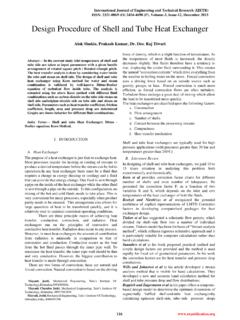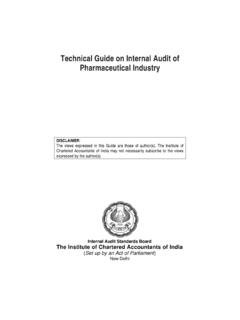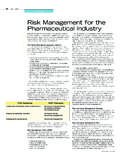Transcription of Clean Room Classification for Pharmaceutical Industry
1 International Journal of Engineering and Technical Research (IJETR) ISSN: 2321-0869, Volume-3, Issue-4, April 2015 241 Abstract A Clean room is an environment, typically used in manufacturing or scientific research that has a low level of environmental pollutants such as dust, airborne microbes, aerosols particles and chemical vapors. More accurately, a Clean room has a controlled level of contamination that is specified by the number of particles per cubic meter at a specified particle size. As per the regulations specified by regulating authority FOOD & DRUG ADMINISTRATION, it is necessary to implement specified norms for all Pharmaceutical & food industries.
2 For this reason, the air conditioning and ventilation system in the Pharmaceutical Industry is one of the most vital elements in the manufacturing process. The working area is sensitive to airborne contamination which is why it is necessary to provide adequate protection from ingress of pollutants. The manufacturing process itself also generates fumes that need to be exhausted from the plant to prevent the contamination of areas in which the production takes place. Only the familiarity with all the specificities of the Pharmaceutical Industry guarantees successful designing and manufacturing of optimal HVAC solution. In this paper, the necessary classifications for Clean air, air handling unit and its different components are discussed. Index Terms Clean Room Specification, Air filter, AHU I.
3 INTRODUCTION Terminology used for Clean room systems: 1. Particle size: Micron = 10-6 m 2. Number of air changes: Integer number indicating ratio of blower capacity of air handling unit to the room volume. 3. Particle count: Number of particles of specified size per of air inside the Clean room. 4. Quality standards for the Clean rooms: a. US FED STD 209E Clean room standards b. ISO 14644-1 Clean room standards c. BS 5295 Clean room standards d. GMP EU Classification 5. AHU: Air handling units 6. HEPA: High-efficiency particulate air II. INTRODUCTION Industrial Clean room is mainly applied in electronics Industry for semiconductor manufacturing. Furthermore, it Manuscript received April 17, 2015. Gaurav A. Chaudhari, Heat Power, Savitribai Phule Pune University/JSPM ICOER Wagholi, Pune,India,9730237586. Dr. Suhas H.
4 Sarje, Professor, Savitribai Phule Pune University/JSPM ICOER Wagholi, Pune, India, 9850969618. extends its application s in new material development and fine chemical Industry , Pharmaceutical & food Industry . One of the industrial Clean room criteria is that, its employment will get the investment capital returned with the improvement of quality and production yield of the products. In short, the investment for industrial Clean room is profitable. What level of Clean room is necessary for what kind of products is determine by the product requirement. It is important to design the higher Clean room for more important production area and lower and economical Clean room for other areas. III. Clean ROOM Classification Table No. (1) US FED STD 209E Clean room standards Class Maximum particles / ISO equivalent 1 35 3 1 ISO 3 10 350 75 30 10 ISO 4 100 3500 750 300 100 ISO 5 1000 35000 7500 3x 1x 7 ISO 6 10000 35x 75x 3x 1x 70 ISO 7 100000 35x 75x 3x 1x 700 ISO 8 Definition of Cleanroom: The definition of cleanroom has been expanded in the ISO 14644 compared to FS 209E, the definition has include the specific internal environmental conditions.
5 The definitions for both FS 209E and ISO 14644 are as follow; FS 209E Clause Define cleanroom as A room in which the concentration of airborne particles is controlled and which contains one or more Clean zones. ISO 14644-1 Clause expanded the definition of a cleanroom to A room in which the concentration of airborne particles is controlled, and which is constructed and used in a manner to minimize the introduction, generation, and retention of particles inside the room and in which other relevant parameters, eg temperature, humidity and pressure are controlled as necessary. Clean Room Classification for Pharmaceutical Industry Gaurav A. Chaudhari, Dr. Suhas H. Sarje Clean Room Classification for Pharmaceutical Industry 242 Table No.
6 (2) BS 5295 Clean room standards BS 5295 Class 1 also requires that the greatest particle present in any sample do not exceed 5 m. Table No. (3) ISO 14644-1 Clean room standards Class Maximum particles / FED STD 209E equivalent ISO 1 10 ISO 2 100 ISO 3 1000 237 102 35 Class 1 ISO 4 10000 2370 1020 352 83 Class 10 ISO 5 100000 23700 10200 3520 832 29 Class 100 ISO 6 1x 237000 102000 35200 8320 293 Class 1000 ISO 7 1x 1020000 352000 83200 2930 Class 10000 ISO 8 1x 3520000 832000 29300 Class 100000 ISO 9 1x 35200000 8320000 293000 Room Air Table No. (4) GMP EU Classification Class Maximum particles / At Rest At Rest In Operation In Operation Class A 3520 20 3500 20 Class B 3520 29 352000 2900 Class C 352000 2900 3520000 29000 Class D 3520000 29000 n/a n/a IV. EQUIPMENT USED IN Pharmaceutical Industry The definition of air handling unit from ANSI/AHRI Standard 430-2009 states that it is "A factory-made encased assembly consisting of a fan or fans and other necessary equipment to perform one or more of the functions of circulating, cleaning, heating, cooling, humidifying, dehumidifying and mixing of " The AHU is used to control the following parameters of the space.
7 Temperature Humidity Air Movement Air Cleanliness Class Maximum particles / Class 1 3000 0 0 0 Class 2 300000 2000 30 Class 3 1000000 20000 4000 300 Class 4 200000 40000 4000 International Journal of Engineering and Technical Research (IJETR) ISSN: 2321-0869, Volume-3, Issue-4, April 2015 243 Components of Air Handling Unit: Here are some of the air handling unit components that may be contained in the equipment. 1. Housing: The housing that contains all the other components of an AHU is usually make of metal, some are painted to prevent corrosion. In sections where the fans and the coil are located, 1-2 inches of polyurethane foam or PU is used to insulate them to prevent the condensation on the panel.
8 Drain pan is also used as a precaution in the event of condensation of water. 2. Blower Section: Centrifugal fan is used to circulate the air to the various parts of the sections in the building. The typical types of fan available are Backward Inclined, Backward Curved, Forward Curved and Airofoil. The selection of the fan will depend on the air volume and the static pressure required of the system. Usually, the designer of the system will use a specialized software to do this selection. In order to reduce the effect of vibration on the panel, the motor and the fan are usually installed on the vibration isolator except when the drive assembly is external to the fan casing. In recent years, the use of variable air volume (VAV) system is becoming more popular as the volume of the air being discharged can be varied depending on the load condition.
9 If the load is high, the fan speed will be higher and if the load is lower, the speed of the fan will be lower. The speed of the fan is varied by using frequency inverter instead of conventional motor such as PSC motor. Frequency inverter provides better control of the fan speed as a whole range of fan speed from super low to super high can now be utilized based on the load conditions required. This technology has enabled better use of energy and is in tandem with the move to go for greener energy. 3. Cooling Coil: Cooling Coil is used to cool and dehumidify the air. Both DX (direct expansion) cooling and CW (chilled water) cooling coils are available for use depending on the system design. The coil diameter, no. of rows of copper tubes are calculated on the basis of surface area required for effective heat transfer.
10 These coils are arranged in rows with different fin spacing. Aluminium fins and copper tubes are used in the design of the coils. The corrosion resistance hydrophilic fins are also used due to its lower cost and lower resistance to the air velocity. 4. Filters: Filters are to remove particles and contaminants of various sizes from the air. The type of air filter being used will very much depend on the application of the system. Panel Filter is a flat and rectangular in shape and provides a minimum low efficiency filtration which is acceptable to the air conditioning Industry . The high velocity filter is arranged vertically whereas the low velocity filter is arranged in V shape. Typical air velocity that moves through the filters is in the range of 2-3 m/s. Table No. (5) Pre- filter and fine filter efficiency BSEN 7794/5 Efficiency Filter Group G1 - Coarse filter G2 - Coarse filter G3 - Coarse filter G4 - Coarse filter F5 40 60 % Fine filter F6 60 80 % Fine filter F7 80 90 % Fine filter F8 90 95 % Very Fine filter F9 95 98 % Very Fine filter HEPA Filter is very efficient and is able to achieve efficiencies up to , removing minute particles and airborne bacteria from the air.














